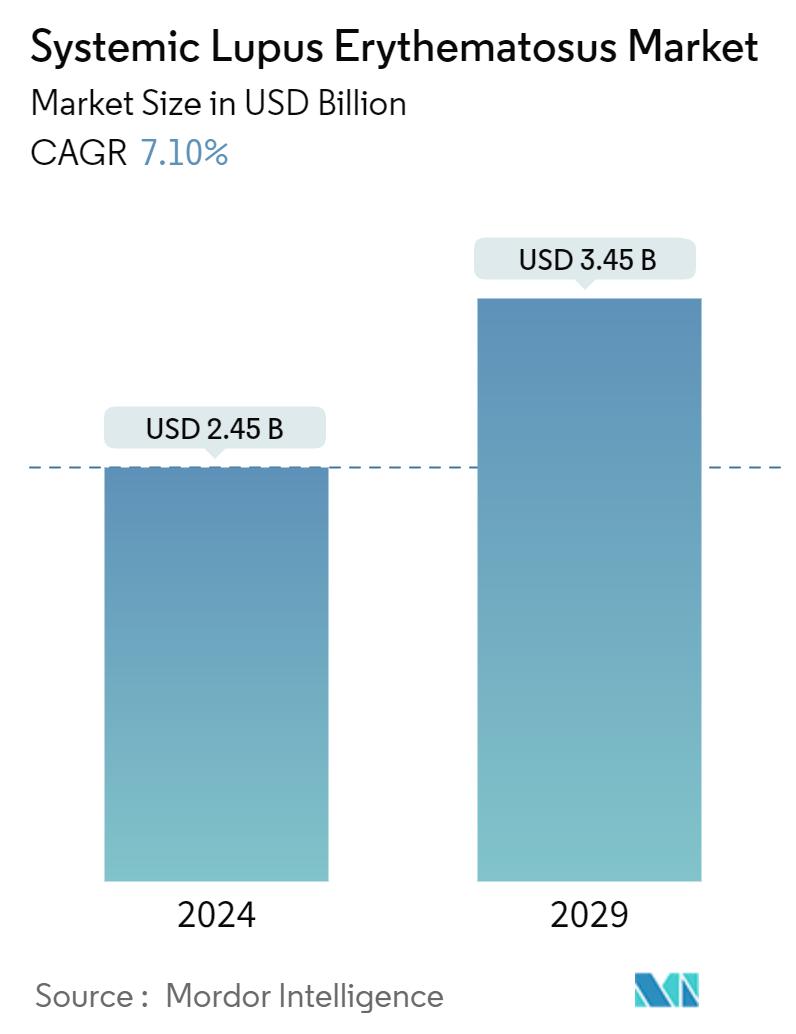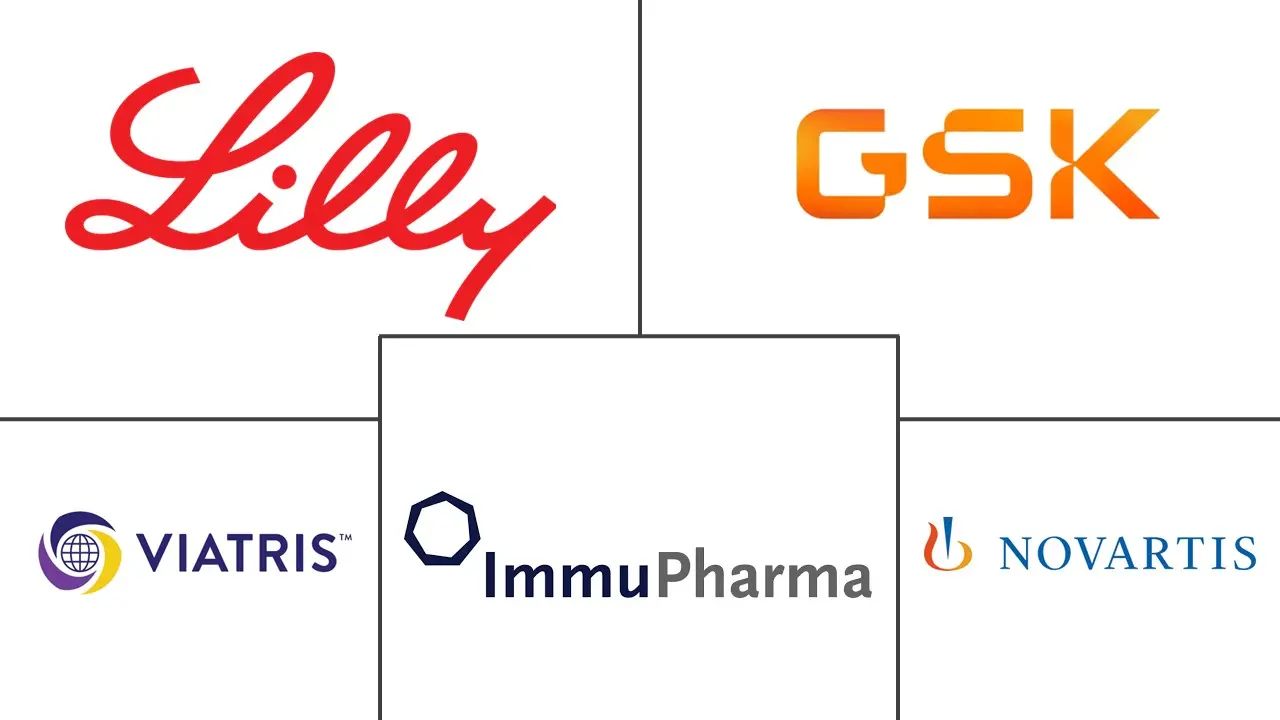Market Size of Systemic Lupus Erythematosus Industry

| Study Period | 2019 - 2029 |
| Market Size (2024) | USD 2.45 Billion |
| Market Size (2029) | USD 3.45 Billion |
| CAGR (2024 - 2029) | 7.10 % |
| Fastest Growing Market | Asia Pacific |
| Largest Market | North America |
Major Players
*Disclaimer: Major Players sorted in no particular order |
Systemic Lupus Erythematosus Treatment Market Analysis
The Systemic Lupus Erythematosus Market size is estimated at USD 2.45 billion in 2024, and is expected to reach USD 3.45 billion by 2029, growing at a CAGR of 7.10% during the forecast period (2024-2029).
COVID-19 has significantly impacted the growth of the systemic lupus erythematosus market because SLE patients are prone to COVID-19 infection on account of the aberrant immune responses inherent to the disease and the frequent treatment of immune suppressants. For instance, according to an article published by the National Library of Medicine, in May 2022, the prevalence of COVID-19 infection varied between 0.0% and 18.1% in SLE patients, and the hospitalization rates ranged from 0.24% to 10.6%. A decline in SLE hospitalization rate was found during the COVID-19 pandemic, and disease flare (38.9%) and infection (22.2%) were considered the main reasons for hospitalization in SLE patients. Furthermore, as per the study published in May 2022, by the National Library of Medicine, during the pandemic, SLE patients with COVID-19 experienced medicine supply shortages, missed medication doses, financial hardships, and psychological suffering. However, currently, as there is better access to drugs as compared to the initial pandemic phase due to the lockdown, the market is expected to gain its growth pace over the coming 3-4 years.
Factors such as the increasing prevalence of systemic lupus erythematosus, growing risk factors, and medical advancements by biopharmaceutical companies in SLE are expected to drive the market over the forecast period. For instance, according to an article published by Frontiers Media S.A., in April 2021, the prevalence rate of SLE varied from 4.8 to 91 per 100,000 people across sexes, age groups, geographical regions, and ethnic backgrounds. The incidence and prevalence rates in people of African or Asian backgrounds were approximately 2-3-times higher than those in white populations. Furthermore, according to a CDC update, in July 2022, poor access to care, late diagnosis, less effective treatments, and poor adherence to therapeutic regimens may increase the damaging effects of systemic lupus erythematosus, causing more complications and an increased risk of death. SLE can affect people of all ages, including children. Thus, when SLE risk factors increase, so does the demand for SLE drugs, propelling the market's growth over the forecast period.
Several biopharmaceutical companies are seeking approval for the advancement of SLE to improve the treatment of SLE including the identification of genetic variations, an enhanced understanding of innate and adaptive immune activation and regulation of tolerance, and dissection of immune cell activation. For instance, in August 2021, AstraZeneca received approval from the United States Food and Drug Administration for Saphnelo (nivolumab-final) for the treatment of adult patients with moderate to severe systemic lupus erythematosus (SLE) who are receiving standard therapy. Additionally, in July 2022, US FDA approved GSK plc's Benlysta (belimumab) for the treatment of children aged 5 to 17 with active lupus nephritis (LN) who are receiving standard therapy. In lupus nephritis, SLE causes kidney inflammation of the small blood vessels that filter wastes in your kidney. BENLYSTA is indicated for patients aged 5 with active SLE. These improvements in clinical trial design, form a platform from which to launch the development of a new generation of lupus therapies.
Thus, the above-mentioned factors are expected to fuel growth in the SLE market over the forecast period. However, the high cost of treatment and several misconceptions and social stigmas are expected to be the primary hindrances.
Systemic Lupus Erythematosus Treatment Industry Segmentation
As per the scope of the report, systemic lupus erythematosus (SLE) is an autoimmune inflammatory disease affecting multiple organs with various clinical manifestations. Joints, skin, kidneys, blood cells, brain, heart, and lungs are all impacted by SLE. SLE is triggered by a combination of genetic and environmental factors, such as medications, infections, and stress. The Systemic Lupus Erythematosus Market is Segmented by Treatment Type (Non-Steroidal Anti-Inflammatory Drugs (NSAIDs), Antimalarials, Corticosteroids, Biologics, and Others), Route Of Administration (Oral, Intravenous, and Others), and Geography (North America, Europe, Asia-Pacific, Middle East and Africa, And South America). The market report also covers the estimated market sizes and trends for 17 countries across major global regions. The report offers the value (in USD million) for the above-mentioned segments.
| By Treatment Type | |
| Non-Steroidal Anti-Inflammatory Drugs (NSAIDS) | |
| Antimalarials | |
| Corticosteroids | |
| Biologics | |
| Others |
| By Route of Administration | |
| Oral | |
| Intravenous | |
| Others |
| Geography | ||||||||
| ||||||||
| ||||||||
| ||||||||
| ||||||||
|
Systemic Lupus Erythematosus Market Size Summary
The systemic lupus erythematosus (SLE) treatment market is anticipated to experience significant growth over the forecast period, driven by factors such as the increasing prevalence of the disease, advancements in biopharmaceuticals, and the development of targeted biologic therapies. The market's expansion is supported by the growing understanding of immune system mechanisms and the identification of genetic variations that contribute to SLE. Biopharmaceutical companies are actively seeking regulatory approvals for new treatments, which are expected to enhance patient outcomes and drive market growth. Despite challenges such as high treatment costs and social stigmas, the market is poised for robust development, particularly with the introduction of biologics that offer more targeted and effective treatment options compared to traditional therapies.
North America is projected to hold a substantial share of the global SLE market, attributed to its advanced healthcare infrastructure, increased disease awareness, and supportive funding from non-profit organizations and government agencies. The region's market growth is further bolstered by the rising incidence of autoimmune diseases and the ongoing clinical studies aimed at evaluating new therapies. The competitive landscape is characterized by the presence of both international and regional companies, with key players like GlaxoSmithKline, AstraZeneca, and Pfizer Limited leading the market. These companies are actively involved in expanding their product offerings and securing approvals for new treatments, which is expected to contribute to the market's growth trajectory over the coming years.
Systemic Lupus Erythematosus Market Size - Table of Contents
-
1. MARKET DYNAMICS
-
1.1 Market Overview
-
1.2 Market Drivers
-
1.2.1 Increasing Prevalence of Systemic Lupus Erythematosus and Growing Risk Factors
-
1.2.2 Medical Advancements by Biopharmaceutical Companies in SLE
-
-
1.3 Market Restraints
-
1.3.1 High Cost of Treatment
-
1.3.2 Several Misconceptions and Social Stigmas
-
-
1.4 Porter's Five Forces Analysis
-
1.4.1 Threat of New Entrants
-
1.4.2 Bargaining Power of Buyers/Consumers
-
1.4.3 Bargaining Power of Suppliers
-
1.4.4 Threat of Substitute Products
-
1.4.5 Intensity of Competitive Rivalry
-
-
-
2. MARKET SEGMENTATION (Market Size by Value - USD million)
-
2.1 By Treatment Type
-
2.1.1 Non-Steroidal Anti-Inflammatory Drugs (NSAIDS)
-
2.1.2 Antimalarials
-
2.1.3 Corticosteroids
-
2.1.4 Biologics
-
2.1.5 Others
-
-
2.2 By Route of Administration
-
2.2.1 Oral
-
2.2.2 Intravenous
-
2.2.3 Others
-
-
2.3 Geography
-
2.3.1 North America
-
2.3.1.1 United States
-
2.3.1.2 Canada
-
2.3.1.3 Mexico
-
-
2.3.2 Europe
-
2.3.2.1 Germany
-
2.3.2.2 United Kingdom
-
2.3.2.3 France
-
2.3.2.4 Italy
-
2.3.2.5 Spain
-
2.3.2.6 Rest of Europe
-
-
2.3.3 Asia-Pacific
-
2.3.3.1 China
-
2.3.3.2 Japan
-
2.3.3.3 India
-
2.3.3.4 Australia
-
2.3.3.5 South Korea
-
2.3.3.6 Rest of Asia-Pacific
-
-
2.3.4 Middle East and Africa
-
2.3.4.1 GCC
-
2.3.4.2 South Africa
-
2.3.4.3 Rest of Middle East and Africa
-
-
2.3.5 South America
-
2.3.5.1 Brazil
-
2.3.5.2 Argentina
-
2.3.5.3 Rest of South America
-
-
-
Systemic Lupus Erythematosus Market Size FAQs
How big is the Systemic Lupus Erythematosus Market?
The Systemic Lupus Erythematosus Market size is expected to reach USD 2.45 billion in 2024 and grow at a CAGR of 7.10% to reach USD 3.45 billion by 2029.
What is the current Systemic Lupus Erythematosus Market size?
In 2024, the Systemic Lupus Erythematosus Market size is expected to reach USD 2.45 billion.

